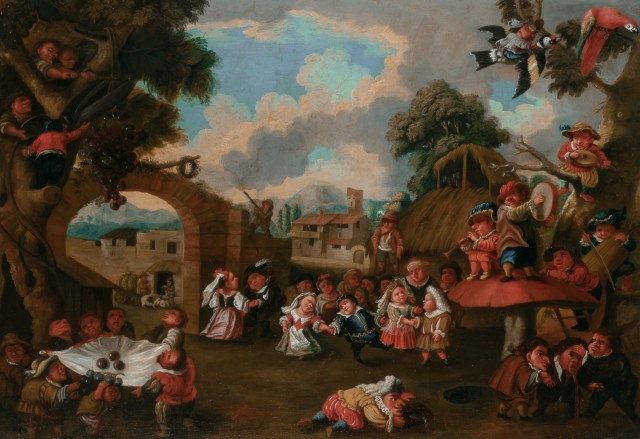Dwarfs in European Art
05/11/2021 Latest News, Old Master Paintings

NEW YORK, NY -- Dwarfs have fascinated artists for centuries. Numerous images of little people appear in paintings and sculpture from the ancient world through the Middle Ages – as figurines, in vase paintings, as architectural ornaments and as marginal figures in medieval manuscripts. Some of these early depictions show their subjects as caricatures of men and women of more normative proportions; but others appear to be purely straightforward observations of the variety of human life.
In the 15th century European artists began to paint portraits of people of short stature who were then serving as attendants to ruling families. ”Court dwarfs” were in vogue among the nobility of Europe, and candidates for the job were recruited from across the continent to meet the demand for their services. The best-known 15th-century image of a court dwarf today is probably the tiny lady-in-waiting to the wife of Marquis Ludovico Gonzaga in Andrea Mantegna‘s 1474 portrait of the family in the Gonzaga palace in Mantua. But other such portraits abound. For example, in another painting from the early 1470s, Botticelli’s Adoration of the Magi now in the National Gallery in London, the Florentine artist depicted a dignified and elegantly dressed dwarf – almost certainly the accurate description of an actual attendant at the Medici court – as the sword-bearer to one of the kneeling kings.
The 17th century was the heyday of paintings of dwarf courtiers, particularly those in the household of Philip IV of Spain. In Madrid the principal painter to the king was no less a master than Diego Velázquez, one of the great portraitists of all time. Velázquez’s sensitive and respectful likenesses of Philip’s court dwarfs – who worked variously as secretaries, entertainers, or playmates for the royal children – are profoundly perceptive and sympathetic evocations of their individual personalities.
Late in the 17th century a new kind of image of little people made its appearance in Europe. This new genre featured crowds of dwarfs dancing, feasting, or engaged in such mock-heroic escapades as capturing a gigantic lobster or battling a regiment of frogs. The best exponent of this new imagery was the 18th-century artist Enrico Albrici (1714-1775), who worked in the north Italian cities of Bergamo and Brescia.
One fine example of Albrici’s painting is Dwarfs Celebrating a Festival. Here the short-statured protagonists dance to the music of a Lilliputian orchestra; some musicians stand on a mushroom while others are seated on the lower branches of a nearby tree. At left a group of revelers sitting in another tree shake a bunch of grapes to loosen the fruit, which is eagerly caught by a second group waiting below. In the distance behind them a rustic dwarf can be seen carrying a squash in a wagon drawn by guinea pigs – common household pets in Europe after they were imported from South America in the 16th century. In the right foreground an unfortunate fellow who has over-indulged in food or drink is led away by two friends. The intention here is certainly comic, with the little people repeating the actions of characters in the paintings of village celebrations that were popular throughout Europe at the time.
Another example of Albrici’s humor is his Dwarfs Cutting a Piece of Cheese, which was apparently a big success with his clientele, since he produced several versions of it. Here an irascible-looking stilt walker oversees the sawing of a gigantic chunk of what looks like aged pecorino. A line of people have gathered to carry off pieces of this delicacy, while others cut off smaller bits nearby. At the lower right an officious fellow in fancy dress drives into the scene in a carriage drawn by guinea pigs, bearing a proclamation of some kind.
Who were the buyers of these paintings? Albrici’s burlesques do not appear in the published inventories of noble families, nor do we find them in the palaces of great princes. Perhaps we can best imagine them in the home of a prosperous artisan or small businessman, an unpretentious patron with no need to see himself elevated by grandiose allegory, someone still close enough to the common experiences of his society to enjoy Albrici’s gently humorous observations of the life around him.
Old Master & 19th Century Paintings & Drawings
Auction Wednesday, May 19, 2021 at 10am
Exhibition May 15-17
The upcoming auction of Old Master & 19th Century Paintings & Drawings features two works depicting dwarfs by Enrico Albrici from the Collection of Ambassador and Mrs. Alfred Hoffman, North Palm Beach.